Key Takeaways
- Partial reps involve shortening the range of motion on an exercise, such as only going halfway down when squatting.
- Full reps involve moving through the entire available range of motion on an exercise, such as squatting “ass to grass.”
- In general, full reps are going to produce more muscle growth and strength gains than partial reps, but both can have a place in your training.
Mosy around any gym, and you’ll see something like this:
And a few questions come to mind.
Is he really getting anything out of those reps?
Is he just doing that to stroke his ego?
Should I train like that?
Some say yes, that partial reps, or repetitions where you only complete part of the movement, lead to superior gains in strength and size.
Others say that unless you take every single rep in your training through the full range of motion, you’re cheating. This pretty much sums up their view:
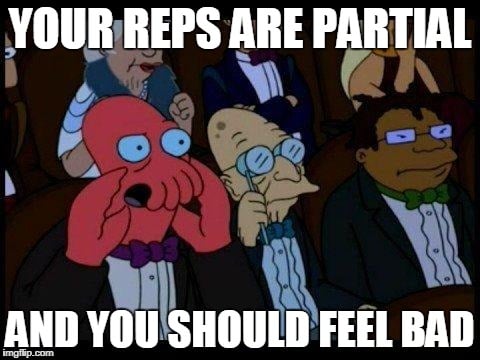
The truth?
They’re both wrong, and you’re going to learn why in this article.
By the end, you’ll know the pros and cons of partial and full range of motion reps, how each affects muscle growth, and when you should and shouldn’t use both in your training.
- What Are Partial Reps?
- Are Partial Reps Better than Full Range of Motion Reps?
- How to Use Partial Reps Properly
- The Bottom Line on Partial Reps for Muscle Growth
Table of Contents
+Want to listen to more stuff like this? Check out my podcast!
What Are Partial Reps?
To answer that question, we first need to define a related term—range of motion.
Range of motion (ROM) means, “The full movement potential of a joint, usually its range of flexion and extension.”
When it comes to strength training, range of motion generally refers to how much you can extend or flex a joint during a particular exercise.
Flexion is when you shorten the angle in a joint, like when you’re curling a dumbbell.
Extension is when you lengthen the angle of a joint, like when you lower the dumbbell toward the ground.
Here’s what this looks like:

So, a full range of motion repetition is one wherein you move your joint from the farthest point of extension to the farthest point of flexion and back.
For example, if you can squat so that your butt almost touches the ground (Ass-To-Grass), then you’re using a full range of motion.
Like this:
On the other hand, a partial range of motion repetition, sometimes called a “partial,” is one wherein you only move your joint well within the limits of flexion and extension.
Like moving between 50 and 100 degrees in this diagram:
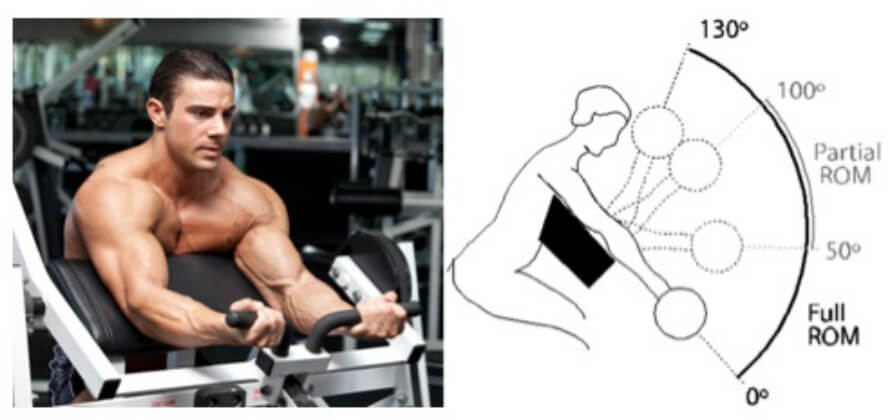
Often, you’ll see people bouncing a weight in the middle part of a movement, like this:
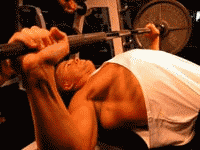
People use partial reps on all kinds of exercises, but they’re usually used on isolation exercises like barbell curls, triceps extensions, crunches, and the like.
Are Partial Reps Better than Full Range of Motion Reps?
There are three reasons people use partial reps in their training:
- They let you use heavier weights while doing the same or a greater number of reps.
- They give you a pump, which many believe will lead to greater muscle growth.
- They allow you to keep constant tension on your muscles, which isn’t always the case with full range of motion reps.
Aside from the third justification, the first two make some sense.
Heavier weights are generally better for muscle growth and doing some pump training can be helpful, but there’s more to the story.
Partial Reps and Muscle Growth
The first reason people train with partial reps is because it allows them to use heavier weights.
For example, let’s say you currently bench 225, bringing the bar all the way to your chest. If you start doing partial reps, only bringing the bar three to four inches above your chest, then you could probably start benching 250 without a problem.
Heavier weights are generally better for muscle growth, so, what’s wrong with shortening the range of motion to get the job done?
While this makes sense on the surface, it’s missing another piece of the puzzle.
Partial Reps and Training Volume
What really drives muscle growth is increasing the volume of mechanical tension you expose your muscles to over time.
In this sense, tension refers to how much resistance your muscles need to generate to move a weight, or how much you’re lifting.
Volume in this case means how much weight you lift, for how many reps, over what distance.
In order to build muscle, you need to increase one or all of those variables over time, which is referred to as progressive overload.
Partial reps allow you to add more weight and reps, but at the expense of shortening the range of motion.
Full reps allow you to use a longer range of motion, but force you to use lighter weights and/or fewer reps.
As you’ll see in a moment, this is sometimes a worthwhile compromise, but most of the time it leads to less muscle growth.
For example, let’s say that you currently bench 225 for 3 sets of 6 reps through a full range of motion every week.
225 x 3 x 6 = 4,050.
In that workout, you bench a total of 4,050 pounds.
Now let’s say you cut the range of motion in half (only bringing the bar about 6 inches above your chest), but add 25 pounds and 2 reps to each set.
Now, you’re benching 250 pounds for 3 sets of 8 reps.
250 x 3 x 8 = 6,000
Now you’re benching 6,000 pounds per workout!
You just upgraded from coach to first class on the gainz train… or so you might think.
There’s just one problem—you’re only moving the weight half as far, so really, you’re only benching 3,000 pounds per workout.
Despite benching 25 pounds more, reducing the range of motion cut your volume by 25%.
This is why most research shows that partial range of motion reps result in less muscle growth, even when people train with heavier weights or more reps.
So, as a general rule, sacrificing range of motion to add weight is only going to make it harder to gain muscle.
What about the pump you get from partial reps, though?
Surely that must count for something, no?
Partial Reps and “The Pump”
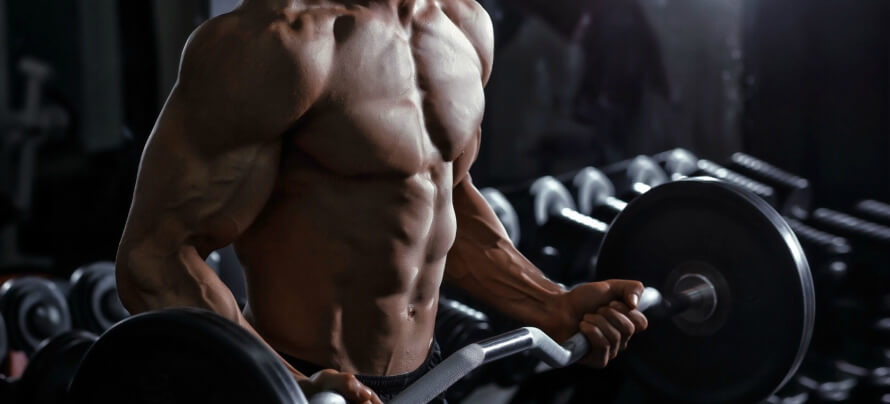
The “pump” refers to the temporary increase in muscle size that occurs when you lift weights, especially when you use higher reps and shorter rest periods.
When you contract your muscles, metabolic byproducts like lactic acid build up in and around the cells.
In response, your body pumps more blood into the muscle to shuttle away these compounds and to provide more oxygen and nutrients to the muscle cells.
A combination of high reps and short rest periods causes a rapid buildup of these metabolic byproducts and a large spike in blood flow, while simultaneously making it harder for blood to escape.
Thus, you get a pump.
Using a shorter range of motion allows you to do more reps in less time, which makes it easier to get a pump.
Does that lead to more muscle growth?
No.
If you want to learn more about pump training, then you can check out my article on that topic, but the short story is that “pump” style training causes about the same amount of muscle growth as heavier lifting.
Heavy weightlifting also has a few other benefits that you can’t get from pump training.
This isn’t to say that it’s worthless—some training styles like blood flow restriction and rest-pause training work partly because they cause a pump—but they aren’t better than traditional lifting techniques.
Partial Reps and Constant Tension
You’ve probably noticed that the difficulty of some movements waxes and wanes depending on where you are in the range of motion.
This is because the amount of tension your muscles need to generate changes throughout each rep.
This is known as the “strength curve” of an exercise, and exercises that expose your muscle to a greater amount of tension throughout each rep are said to have a better strength curve.
For example, squats are almost always hardest about a quarter of the way into each rep, and become easy when you get close to standing. They have a good strength curve on the whole, though, because there’s really never a point during the rep where your muscles aren’t working hard.
Biceps curls are hardest when your arm is extended and become easy as you lift the bar closer to your shoulder. They have a decent strength curve, but not quite as good as squats (which is true of most isolation exercises, that’s one of their faults).
Triceps presses are hardest when your arms are fully flexed and become easy when your arms are close to straight. Thus, this exercise has a poor strength curve. That doesn’t mean you should never use it, but it’s a limitation you’ll need to consider.
This means that the muscle is working harder during some portions of the movement than others, and thus isn’t getting trained evenly throughout the exercise.
So, what to do about this?
Well, one solution would be cutting off the easy part of the movement.
If your triceps are breezing through the top portion of the exercise, why even bother doing that part?
Wouldn’t that improve the quality of our reps, since we’re keeping tension on the muscle during the entire set?
Researchers tested that idea in a study published in 2017 in The Journal of Strength and Conditioning Research. They found that people who used a partial range of motion for the triceps overhead press gained twice as much muscle as people who used a full range of motion.

Let’s not get too excited, though.
There are a few confounders in this study, such as the fact that the group using the partial range of motion was probably able to train harder. There’s also some question as to how accurately the measurements were taken, but all in all, it does seem that using partial reps might be useful for some exercises.
You probably don’t want to start using partial reps for all of your exercises, though.
Most studies show that even for accessory exercises, a full range of motion causes more muscle growth.
In addition, this probably works best on exercises that get significantly easy during certain portions of the lift (ones that have a poor strength curve), like triceps overhead press or side raises.
For example, maybe you don’t need to lower dumbbells all the way down to your thighs when doing side raises. Instead, you could only bring them down about 5 to 6 inches from your thighs, where the exercise starts to get easy.
For skull crushers, you could stop the rep when your elbows are still slightly bent.
For leg extensions, you could stop the rep when it starts to get easy (usually when your foot starts to get close to the floor on most machines).
I also wouldn’t use partial reps on all of your isolation exercises. Instead, you could use full range of motion reps for your first set or two, and then finish with a set of partial reps, aiming to do more total reps with the same weight.
Here’s what this might look like for something like leg extensions:
Set 1
6 to 8 reps at 75 to 80% of your one-rep max (1RM)
Full range of motion
Set 2
6 to 8 reps at 75 to 80% of your 1RM
Full range of motion
Set 3
10 to 12 reps at 75 to 80% of your 1RM
Partial range of motion
Partial Reps and Strength Gains
When it comes to strength training, the results are more clear cut:
Full range of motion reps are almost always better than partial reps.
This is true for accessory exercises, like leg extension and curls, as well as compound exercises like the bench press and squat.
There is one exception to this rule, though.
Partial reps generally only make you stronger during the portion of the lift you train. If you only trained with partial reps, then you’d likely end up weaker on the parts of the lift that you didn’t train.
For example, if always do half squats, the day you try to do a full squat is going to be a painful reckoning.
The second you dip below your normal range of motion, you’re going to be significantly weaker.
If you have a sticking point, though—a part of the lift that’s particularly challenging—then training that part of the movement with partial reps might help you become stronger. Powerlifters often do this with bench press, for instance.
Many people have a sticking point about 2 to 4 inches above their chest, so powerlifters will often do board presses, which look like this:
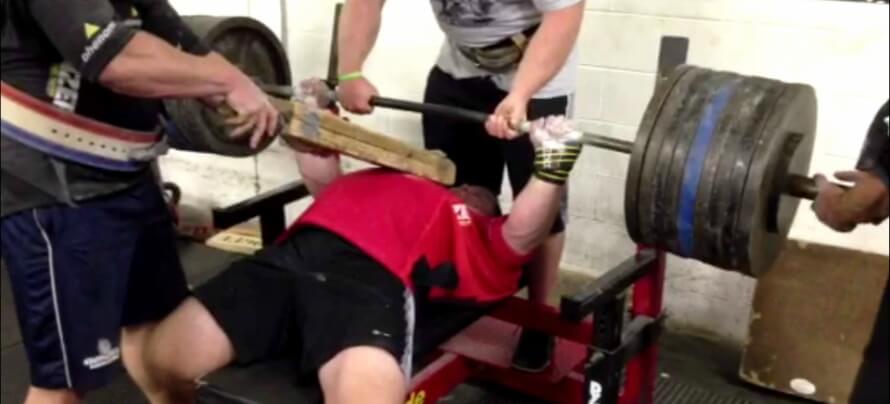
This limits the range of motion to the part of the lift that’s hardest, and allows them to train that “sticking point” with more volume.
These people have also racked up years under the bar, though, and unless you’ve also paid your dues, you’re better off using other techniques to break through strength plateaus.
Unless you’ve been following a well-designed strength training plan for two to three years, and you’re sure you aren’t plateaued for some other reason, then it’s not worth playing with partial reps on your compound lifts.
How to Use Partial Reps Properly
By and large, full reps are better than partial reps for building muscle and strength.
This is particularly true if you’re new to weightlifting, in which case you’re going to get the best bang from your training buck by training exclusively with full range of motion reps.
If you’ve been lifting for more than two or three years though, and you’ve exhausted most of your newbie gains, it might be worth incorporating some partial reps into your training.
Here’s how:
1. Use a combination of full and partial reps.
Most research shows that full reps are better than partial reps for all kinds of exercises, so you don’t want to eliminate full range of motion reps entirely.
Instead, do several full range of motion sets first, and then do one or two partial range of motion reps to squeeze in more volume.
Here’s that same example from earlier:
Set 1
6 to 8 reps at 75 to 80% of your one-rep max (1RM)
Full range of motion
Set 2
6 to 8 reps at 75 to 80% of your 1RM
Full range of motion
Set 3
10 to 12 reps at 75 to 80% of your 1RM
Partial range of motion
Or, you could do full and partial range of motion reps on different days.
For example, you could do bicep curls with full range of motion reps on Monday, and train them with partial range of motion reps and heavier weights on Thursday.
Here’s what this might look like:
Monday
3 sets of 6 to 8 reps at 75% of your one-rep max (1RM)
Full range of motion reps
Thursday
3 sets of 10 to 12 reps at 75% of your one-rep max
Partial range of motion reps
Note that normally, it would be difficult to use 75% of your one-rep max for 12 reps, but by shortening the range of motion you’re able to use heavier weights.
2. Use partial range of motion reps on accessory exercises.

The main benefit of partial reps is that they allow you to keep constant tension on the muscle throughout the movement. This isn’t normally a problem with heavy, compound lifts, which cause a large amount of tension through the full range of motion.
It can be more of an issue, though, with exercises that don’t stress the muscle evenly throughout the full range of motion, like curls, tricep extensions, and leg extensions.
If you’re going to use partial reps at all, use them on your accessories, not your main lifts.
(The one exception is if you’re following a powerlifting program that calls for partial reps, but unless you’re an advanced lifter, you probably aren’t.)
3. Make sure you’re still getting stronger.
All of the normal rules of muscle growth still apply regardless of what range of motion you use.
If you don’t get stronger, you won’t get bigger, and that’s true whether you use partial or full range of motion reps.
Keep track of how much you’re lifting workout to workout, and make sure you try to add weight as often as you can while maintaining good form.
The Bottom Line on Partial Reps for Muscle Growth
Many people think that partial range of motion reps lead to more muscle growth than full range of motion reps.
The typical reasons for this are that partial reps…
- Allow you to use heavier weights for more reps
- Give you better pumps
- Keep more tension on the muscle
In reality, partial reps actually reduce the amount of total work your muscles have to do, and often lead to a decrease in muscle growth.
While they do cause larger pumps, that doesn’t lead to more muscle growth.
Finally, keeping more tension on the muscles might be helpful for some accessory exercises, but in most cases you’ll get as good or better results with full range of motion reps.
In the final analysis, you aren’t missing out by not using partial range of motion reps.
If you want to use them, though, stick to these three rules:
- Use a combination of full and partial reps.
- Use partial range of motion reps on accessory exercises only.
- Make sure you’re still getting stronger.
And above all else, don’t forget to keep adding weight and tracking your workouts. Do that, and you’ll see results.
P.S. Did you enjoy this article? If so, would you mind sharing it on Facebook, Twitter, or wherever else you like to hangout online? Thanks!
What’s your take on full or partial reps? Have anything else to share? Let me know in the comments below!
Scientific References +
- Hernández-Preciado, J. A., Baz, E., Balsalobre-Fernández, C., Marchante, D., & Santos-Concejero, J. (2018). Potentiation effects of the French contrast method on vertical jumping ability. Journal of Strength and Conditioning Research, 32(7), 1909–1914. https://doi.org/10.1519/JSC.0000000000002437
- Massey, C. D., Vincent, J., Maneval, M., & Johnson, J. T. (2005). Influence of range of motion in resistance training in women: Early phase adaptations. Journal of Strength and Conditioning Research, 19(2), 409–411. https://doi.org/10.1519/R-14643.1
- Pinto, R. S., Gomes, N., Radaelli, R., Botton, C. E., Brown, L. E., & Bottaro, M. (2012). Effect of range of motion on muscle strength and thickness. Journal of Strength and Conditioning Research, 26(8), 2140–2145. https://doi.org/10.1519/JSC.0b013e31823a3b15
- Graves, J. E., Pollock, M. L., Jones, A. E., Colvin, A. B., & Leggett, S. H. (1989). Specificity of limited range of motion variable resistance training. Medicine and Science in Sports and Exercise, 21(1), 84–89. https://doi.org/10.1249/00005768-198902000-00015
- Pinto, R. S., Gomes, N., Radaelli, R., Botton, C. E., Brown, L. E., & Bottaro, M. (2012). Effect of range of motion on muscle strength and thickness. Journal of Strength and Conditioning Research, 26(8), 2140–2145. https://doi.org/10.1519/JSC.0b013e31823a3b15
- Hartmann, H., Wirth, K., Klusemann, M., Dalic, J., Matuschek, C., & Schmidtbleicher, D. (2012). Influence of squatting depth on jumping performance. Journal of Strength and Conditioning Research, 26(12), 3243–3261. https://doi.org/10.1519/JSC.0b013e31824ede62
- Vianna, J. M., Lima, J. P., Saavedra, F. J., & Reis, V. M. (2011). Aerobic and Anaerobic Energy During Resistance Exercise at 80% 1RM. Journal of Human Kinetics, 29A(Special Issue), 69–74. https://doi.org/10.2478/v10078-011-0061-6
- McMahon, G. E., Morse, C. I., Burden, A., Winwood, K., & Onambélé, G. L. (2014). Impact of range of motion during ecologically valid resistance training protocols on muscle size, subcutaneous fat, and strength. Journal of Strength and Conditioning Research, 28(1), 245–255. https://doi.org/10.1519/JSC.0b013e318297143a
- Pinto, R. S., Gomes, N., Radaelli, R., Botton, C. E., Brown, L. E., & Bottaro, M. (2012). Effect of range of motion on muscle strength and thickness. Journal of Strength and Conditioning Research, 26(8), 2140–2145. https://doi.org/10.1519/JSC.0b013e31823a3b15
- Helms E. R., Fitschen P. J., Aragon A. A., Cronin J., & Schoenfeld B. J. (n.d.). Recommendations for natural bodybuilding contest preparation: resistance and cardiovascular training - The Journal of Sports Medicine and Physical Fitness 2015 March;55(3):164-78 - Minerva Medica - Journals. Retrieved November 4, 2020, from https://www.minervamedica.it/en/journals/sports-med-physical-fitness/article.php?cod=R40Y2015N03A0164&acquista=1
- Schoenfeld, B. J. (2010). The mechanisms of muscle hypertrophy and their application to resistance training. In Journal of Strength and Conditioning Research (Vol. 24, Issue 10, pp. 2857–2872). J Strength Cond Res. https://doi.org/10.1519/JSC.0b013e3181e840f3










